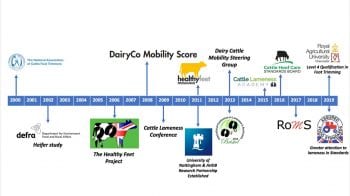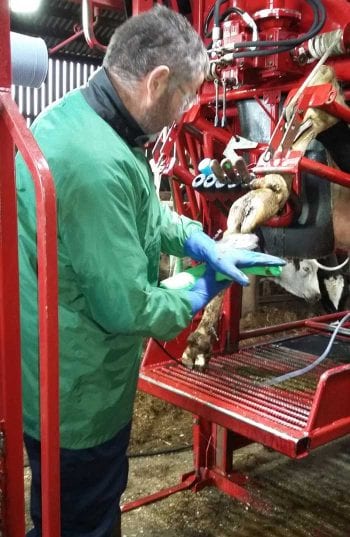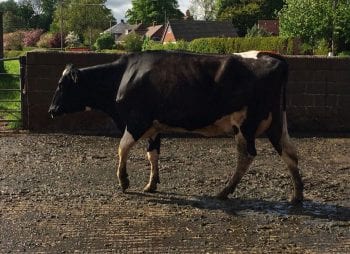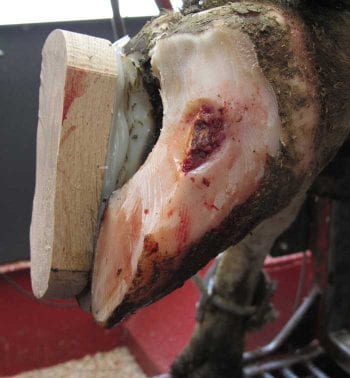16 Feb 2021
Focus on feet in cattle and sheep
Sara Pedersen discusses why lameness can be a challenge, before looking at existing and new industry measures to tackle its impact.

The past 20 years has seen an increasing focus on lameness in dairy cattle and its impact on welfare, with a huge amount of activity as a result (Figure 1).
As the most common and visible source of distress in cattle, it represents a real risk to the reputation of the dairy industry, as well as resulting in significant economic losses – conservative estimates suggest around £450 million per year across the UK.
With the latest available studies suggesting average lameness levels on dairy farms are still around 30% (Griffiths et al, 2018), it indicates that lameness is likely to continue to rise up the agenda.
Why is lameness such a challenge?

Despite lameness being a very obvious disease to the trained eye, it is sometimes difficult to initiate change in farmer behaviour and attitude towards lameness. The challenges typically centre around a failure to recognise lameness as an issue, failure to truly appreciate the economic impact of lameness, and a perception that addressing lameness is costly and unachievable – for example, the view that it can only be solved through investing in new infrastructure.
The social science aspect regarding the perceived challenges and motivators involved in tackling lameness are well-documented in the literature (Leach et al, among others). However, it is also apparent that when farmers do invest time in tackling lameness, it can reap rewards.
Many successful stories can be found in the farming press and, although fewer in number, also in the published literature (Main et al, 2012). However, if we are truly going to tackle lameness at a national level, we need to ensure the subject rises up the agenda, both within the veterinary profession and also at farm level.
Tackling lameness on farm: a national scheme
The Agriculture and Horticulture Development Board (AHDB) Healthy Feet Programme was launched in 2011 on the back of the Healthy Feet Project run by the University of Bristol.
Since its launch, hundreds of farmers across the UK have benefited from the advice and guidance provided by trained mobility mentors. However, with the future aim being to reduce the levels of lameness in the national herd from the current 30% to below 10%, it is clear more farmers would benefit from its supportive approach to lameness reduction.
A study by Reaseheath College in Nantwich (Atkinson, 2013) demonstrated just how effective the Healthy Feet Programme can be, with farmers seeing a 30% proportional reduction in lameness prevalence in just one year, with the most proactive farmers seeing up to a 50% reduction. With a proven programme available to assist farmers, now is a key time to drive greater uptake.
This year sees the Healthy Feet Programme have a revamp, with a new “HFPLite” version launched to help farmers take the first step towards improved lameness prevention without having to commit to the full programme. The Mobility Mentor training is now open to vets with at least one year’s experience (previously two years), along with farm consultants and advisors who can demonstrate they have knowledge in foot trimming and lameness.
As part of the revamp, new delivery methods of lameness knowledge exchange are being rolled out, including facilitated farmer action groups, which are based on the stable school approach used to tackle antimicrobial use. While this approach has been applied in research, it is yet to be adopted widely in the field for lameness. It is hoped increasing the variety of ways farmers can engage in lameness knowledge exchange will drive greater uptake of management programmes.
Foot trimming industry: what’s new?
When it comes to foot trimming, the past 20 years has seen a substantial move towards establishing greater levels of professionalism and accountability in the foot-trimming profession. The foot trimmer has an important role to play in the hoof health team on farm, yet no legislation exists that states professional foot trimmers must be qualified or even trained.
While some milk buyers stipulate their suppliers should use registered or accredited foot trimmers, this does not seem to be widely enforced.
Trimming associations and quality assurance

Recognising the need for a greater level of professionalism in the foot trimming industry, the National Association of Cattle Foot Trimmers (NACFT) was formed in 2000 with the mission of promoting excellence in cattle foot care through increasing the credibility and professionalism within the industry.
With more than 100 members across the UK, the association has played a huge role in driving the industry forward in the past 20 years through bringing like-minded trimmers together to promote the profession and offer career progression. NACFT’s annual conference attracts trimmers from across the world to discuss latest developments in the trimming world and share ideas.
The formation of the NACFT and promotion of professionalism has ensured the trimmer has become a valued and pivotal part of the hoof health team on farm, which is essential when it comes to tackling lameness on farm (Figure 2). However, the lack of regulation within the profession has presented many challenges.
In response to this and an identified need for change, the Cattle Hoof Care Standards Board (CHCSB) was formed in 2016 to complement the NACFT by offering a robust quality assurance system. The mission of the CHCSB is to develop a robust set of standards for professional hoof trimming, against which hoof trimmers can be robustly audited.
The standards not only encompass hoof trimming, but also the professionalism, biosecurity, health and safety awareness and record keeping of the hoof trimmer. The standards themselves are heavily based on evidence, and updated and reviewed to ensure they always represent the latest best practice.
Trimmers are assessed against the standards during an unannounced field-based audit, in much the same way as TB testing audits are carried out. The evidence base from the medical field shows this method of auditing allows a much better assessment of normal working practices in comparison to a pre-arranged examination setting.
The development of the standards and the introduction of spot-audits is a positive step forward when it comes to raising and maintaining the standard of professional trimming. However, challenges will always remain, until such a time as regulation becomes mandatory. In the meantime, vets play an important role in ensuring all those trimming on their farms are trained, qualified and regulated.
Foot-trimming qualifications
The Dutch Diploma (awarded through PTC+ Friesland, the Netherlands) and City and Guilds’ NPTC Level 3 qualification in cattle foot trimming have long been the two options when it comes to achieving “qualified” status as a foot trimmer. However, due to lack of demand, the NPTC Level 3 Qualification ceased to be awarded at the end of 2019.
The Royal Agricultural University and CHCSB worked together to produce a Level 4 qualification on bovine lameness and professional cattle foot trimming. As well as being highly practical, the course also includes mobility scoring (for Register of Mobility Scorers accreditation) and lameness prevention and control.

The first course was launched in September 2019, with the first two candidates achieving a Level 4 qualification shortly afterwards. The high demand for the courses is very encouraging when it comes to the future of cattle foot trimming, and in striving towards achieving and maintaining standards.
Treating claw horn disruption lesions (CHDLs): current best practice and what’s on the horizon.
When it comes to treating lameness, the mantra of “early detection and prompt effective treatment” still stands. Yet very few farms that adopt regular mobility scoring and then treat following the established evidence-based best practice recommendations.
Fortnightly mobility scoring (Figure 3) – followed by prompt treatment of new cases of CHDLs with a trim, block and NSAID (Thomas et al, 2015) – remain best practice recommendations (Figure 4). However, despite this pivotal piece of research providing an intervention suitable for the majority of farms, applying this protocol at farm level can be difficult.
In many cases, it takes a team discussion to ensure coordination of relevant parties, for example, independent mobility scorer and external foot trimmer to ensure it is achievable. Communication is also essential between scorer, trimmer and vet to ensure the correct cows for treatment are identified from the mobility score and the necessary protocols are in place so NSAIDs are given to the cows requiring them – that is, new cases of sole bruising, sole ulcer and white line disease.

The research by Thomas et al (2015) has informed further research on the treatment of CHDLs and the potential role that NSAIDs play. A three-year randomised clinical trial will come to an end later this year, which has been undertaken by James Wilson through the AHDB and University of Nottingham research partnership.
Much like the previous research by Thomas et al (2015), the study is assessing the outcome of different treatments in new cases of lameness so we can add to the evidence base surrounding the treatment of CHDLs and better inform best practice protocols.
With lameness rising up the agenda, vets have never had a greater opportunity to take the lead and help tackle the lameness levels affecting the industry. The past 20 years has seen a big leap in terms of our knowledge surrounding the best way to not only treat lameness, but also prevent it.
With the evidence base expected to grow in the next couple of years and the establishment of different delivery methods for knowledge exchange, we can have no more lame excuses.
Useful links
Cattle Hoof Care Standards Board (www.hoofcarestandards.co.uk)
The Healthy Feet website (www.cattle-lameness.org.uk)
The National Association of Cattle Foot Trimmers (www.nacft.co.uk)
Panel 1. To trim or not to trim?
When it comes to whether to trim, advice between the different farm species is conflicting. In dairy cattle, evidence, albeit sparse, suggests preventive trimming can assist in reducing the instance of lameness due to CHDLs. However, concerns remain of the risk that trimming could exacerbate lameness due to infectious causes, for example, digital dermatitis.
Current best practice recommendations involve preventive trimming by a qualified foot trimmer around drying off (with or without an early lactation trim) while observing good biosecurity.
However, in sheep the evidence leads to different best practice recommendations. In contrast to dairy cattle, the majority of cases of lameness in sheep are due to infectious causes, such as footrot and contagious ovine digital dermatitis.
Research demonstrates routine trimming may encourage the spread of these two conditions and, in the case of footrot, actually delay healing. Instead, it is recommended time is better spent on observation and identification of new cases of lameness.
Latest news

